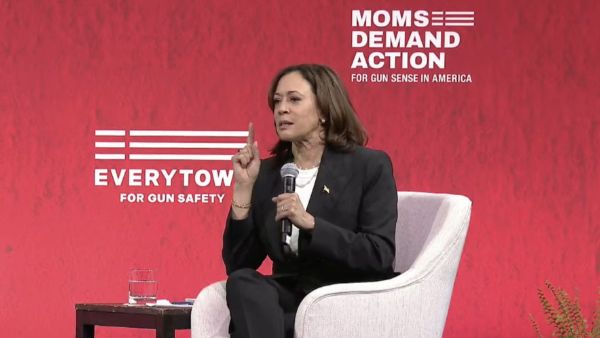
By
Last Friday, Vice President Kamala Harris made her way to Chicago, taking the stage at McCormick Place to address the “Everytown for Gun Safety” conference. This event brought together a sea of predominantly white women wearing red “Everytown moms against gun violence” T-shirts, creating a stark visual contrast that left me pondering the meaning of juxtaposition.
Everytown for Gun Safety, as described on its website, boasts nearly 10 million members dedicated to ending gun violence. It’s a noble cause I was largely ignorant of until that moment. As I entered the convention center, I couldn’t help but notice the palpable energy in the crowd, akin to an all-girls first-year class awaiting a pep rally. Vendors lined the back wall, focusing on various aspects of gun safety and violence prevention, but the absence of diversity was conspicuous.
This stark lack of racial representation led me to reflect on the term “juxtaposition.” While gun violence is pervasive in America, it disproportionately plagues Black communities.
Chicago, where the conference took place, has often been portrayed in the media as ground zero for gun violence, and these issues have frequently been framed along racial lines. Yet, inside McCormick Place, the attendees did not mirror the grim realities just beyond its doors, where victims and perpetrators of gun crimes reside.
As Grey’s Anatomy actor Jason Winston George and an Everytown executive introduced Vice President Harris to an enthusiastic crowd, it became evident that this event was as much about optics as it was about substance. The first order of business was orchestrating a photo opportunity with the Vice President and the crowd.
It’s hard to recall a recent local or national election that didn’t exploit the narrative of Chicago’s violence to signal what should be done for or against gun safety. Depending on your political alignment, Chicago becomes a poster child to advocate for more significant gun restrictions or assert the need for personal firearm ownership. Both arguments are valid, but only within the context of the racial biases that shape gun legislation.
Vice President Harris, unsurprisingly, leaned toward advocating for stricter gun control. Softball questions from George set her up to deliver the expected response: “Just vote for us.”
The Racial Disparities of the Gun Violence Issue
The event’s pageantry and showmanship were impressive, but my disappointment stemmed from the need for more substantive discourse.
It appears that depth of thought has become antiquated in American politics. Politicians understand that nuanced ideas rarely win elections. Instead, they appeal to our primitive instincts, making emotional appeals to elicit responses. The juxtaposition of a crowd of white women advocating for stricter gun laws while the issue disproportionately affects Black and Brown communities was thought-provoking.
Gun violence overwhelmingly hurts communities of color due to a lack of investment coupled with weak gun laws. To combat this issue, U.S. policymakers should pair common-sense gun legislation with investments in community-based violence intervention and policies addressing the root causes of gun violence.
The statistics are telling:
- Young Black Americans experience the highest rates of gun homicides.
- Black Americans are ten times more likely than white Americans to die by gun homicide, with Black men being eighteen times more at risk.
- In 2020, 61 percent of all gun homicides were of Black Americans, who comprise just 12.5 percent of the population.
These facts illustrate the stark racial disparities at the heart of the gun violence problem.
What often remains unspoken is the profit-driven nature of a racist system. Policymakers should confront discriminatory policies in policing, housing, education and employment to tackle the root causes of gun violence.
However, this is unlikely to happen because many profit from the status quo. Prisons, funeral homes and even the police benefit from the current state of affairs.
A quick glance at Everytown’s annual budget of $14 million and its 300 employees reveals that even organizations ostensibly dedicated to addressing gun violence can become part of a system perpetuating racial disparities.
As the 2024 presidential election draws nearer, I’m acutely aware of the pervasive impact of gun violence, particularly within my community. I attended this event hoping to hear concrete solutions.
My expectations were modest: I wanted an honest evaluation of the problem. Regrettably, I departed without either. As the crowd erupted in applause when the Vice President concluded her speech, I questioned whether my disappointment was unique to me. Could I bear some unconscious biases, or did I inadvertently overlook a crucial aspect of the discussion?
As I left the convention and headed to a nearby barbershop, I talked with the barber, mentioning that I had just attended Kamala Harris’s speech. His response, “Who’s Kamala Harris?” – a poignant juxtaposition indeed.
The opinions expressed in this column are that of the writer and do not necessarily reflect those of the Chicago Defender.
The post COLUMN: Juxtaposition: Kamala Harris’s ‘Everytown’ Speech and the Racial Dynamics of Gun Violence appeared first on Chicago Defender.



